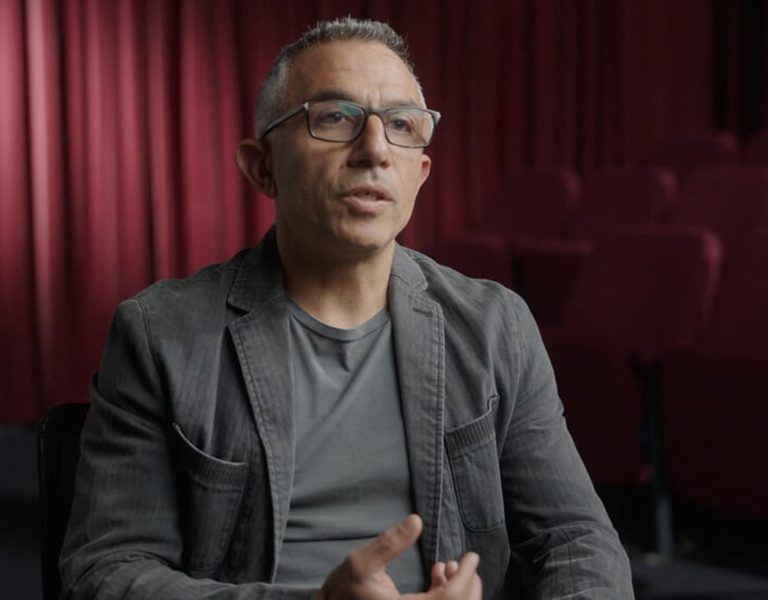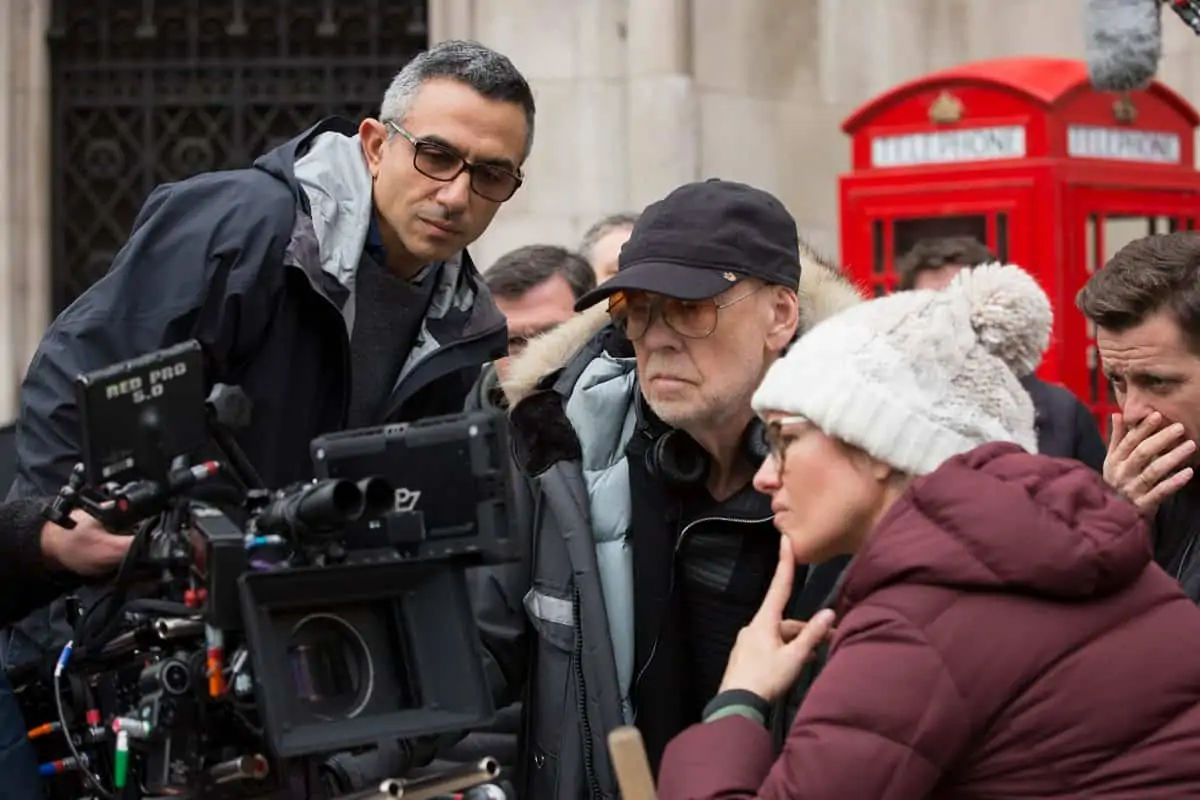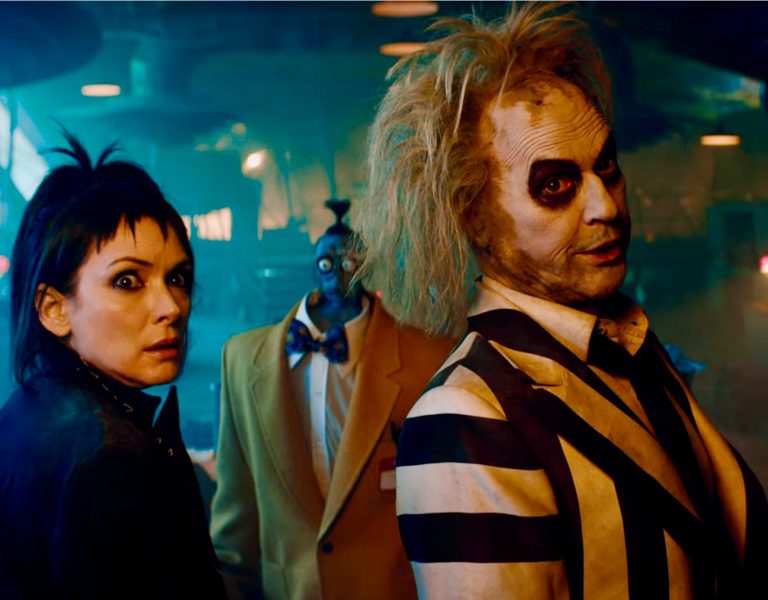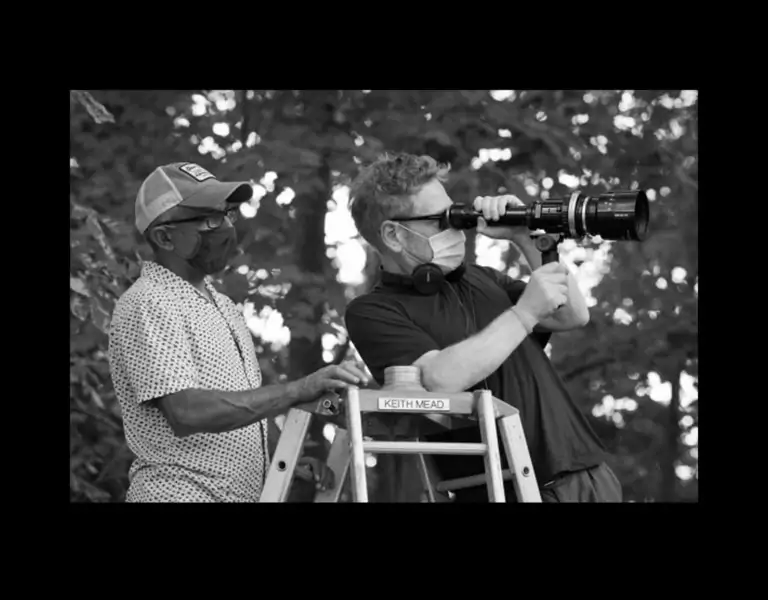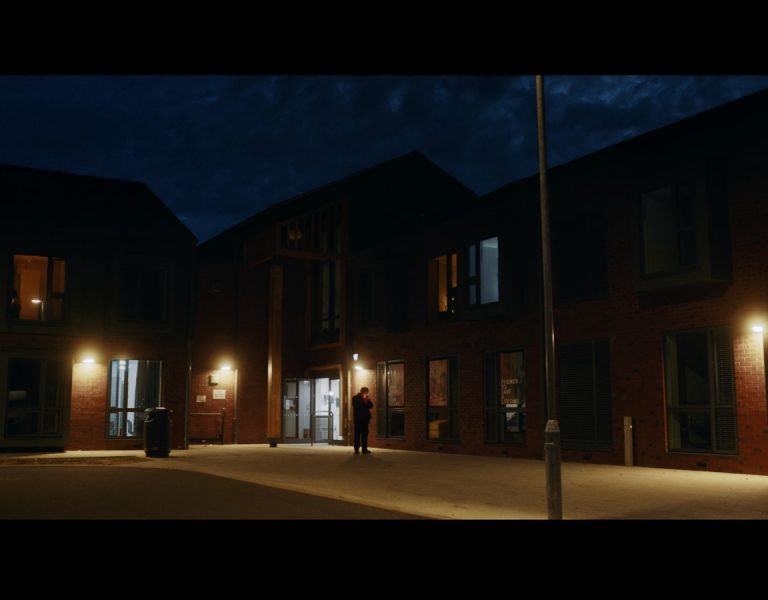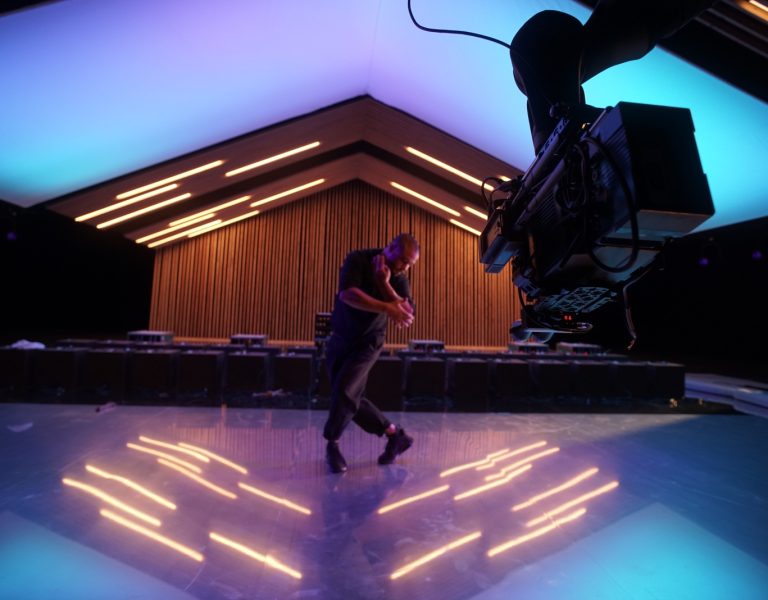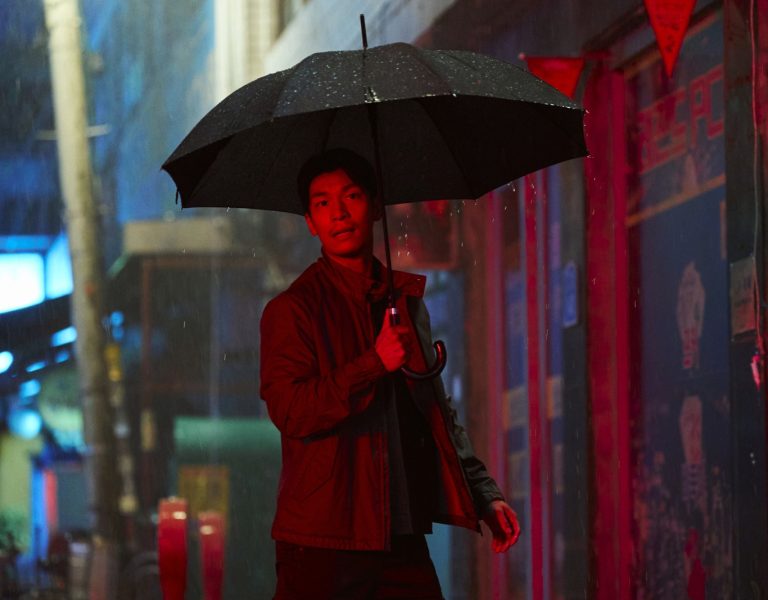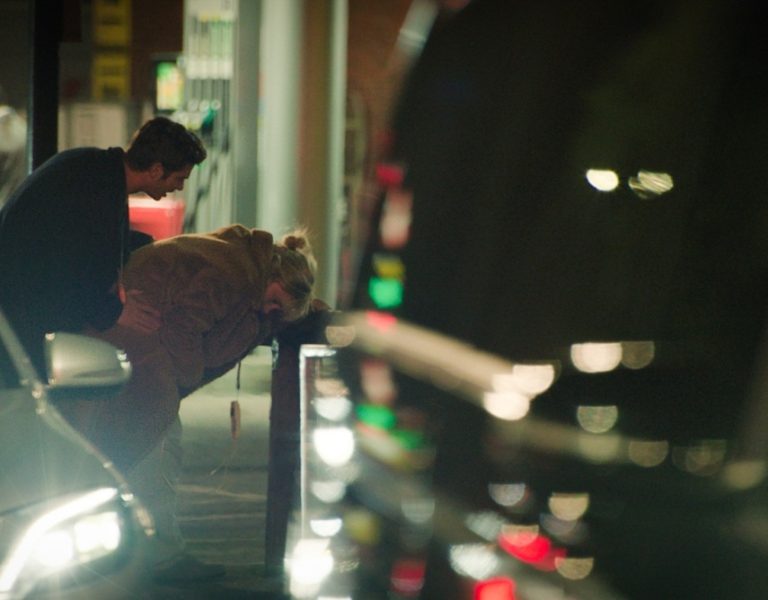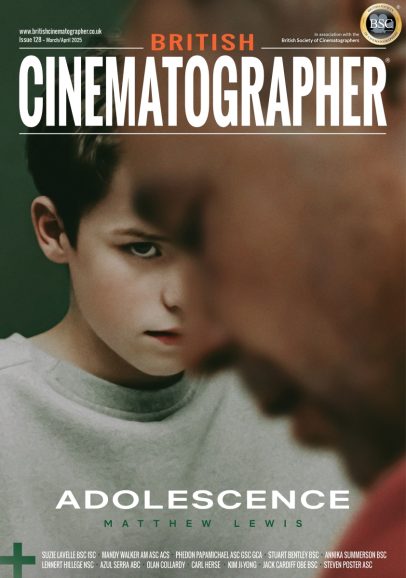A SEQUEL WITH SPIRIT
Director Tim Burton makes a frightfully good return to the Afterlife, continuing the tale of cult classic Beetlejuice and trusting in Haris Zambarloukos BSC GSC to lense the spooky sequel.
Admired by many, director Tim Burton’s Beetlejuice lives long in the memory of audiences who have immersed themselves in the unique world of fear and fun since the film’s 1988 release. The movie follows a recently deceased couple who hire trickster spirit Beetlejuice (Michael Keaton) to help them create chaos to drive out the family who have moved into their home.
Almost four decades later, when Burton decided to return to the Afterlife and explore the next chapter in the story the pressure was on for cast and crew to create a fitting follow-up to the cult classic. In Beetlejuice Beetlejuice, Keaton dons his signature black-and-white stripes once again to reprise his iconic role, alongside Winona Ryder (Lydia in the original, the teen daughter Beetlejuice attempts to scare away), Catherine O’Hara (Lydia’s mother Delia Deetz) and new cast members Jenna Ortega (Lydia’s daughter Astrid), Justin Theroux, Monica Bellucci, and Willem Dafoe.
The story continues following an unexpected family tragedy, when three generations of the Deetz family return home to Winter River. Still haunted by Beetlejuice, Lydia’s life is upended when daughter Astrid accidentally opens the portal to the Afterlife is accidentally, unleashing chaos.
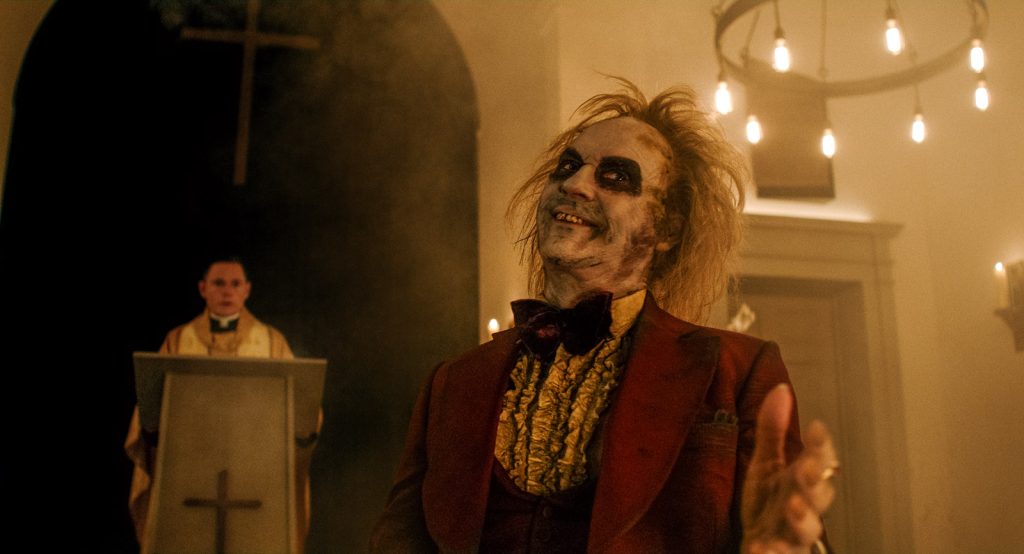
Getting in the spirit
Although Burton has worked with many technologies since Beetlejuice, live effects, puppets, makeup and sets were “part of the spirit” of the original and important to incorporate into the sequel, offering energy and spontaneity.
“That was an important thing for me – from effects to sets and everything – just across the board, no digital,” Burton explains. “Let’s just go back and make it like we did in the past. So, it felt like a weird performance art piece and it took a little while. But, for me, it’s worth it.”
Also keen to use practical techniques and capture as much in camera as possible was cinematographer Haris Zambarloukos BSC GSC. Having worked with Zambarloukos on Jack Ryan, producer Tommy Harper asked if he could put him forward to shoot Beetlejuice Beetlejuice. “Even if I wasn’t available, I would have said yes,” says Zambarloukos. “I learned from our short meeting that Tim is an incredibly visual man of very few words which set the tone for the film.”
Lensed by Thomas E. Ackerman ASC, Beetlejuice’s release made a “massive impact” on the then 18-year-old Zambarloukos. “I’d never seen anything like it. I had no idea I would be in film at that stage but I knew Beetlejuice bridged so many rivers of inspiration and visual complexity. So to say I was scared going into this production is underplaying it. I was petrified.”
Aware of Burton’s preference to visually represent ideas using sketches early in prep, Zambarloukos rewatched many of the director’s films. “I loved all of them, and thought before asking questions, why not see if I could answer them by looking at his previous movies?”
Zambarloukos – who has developed a strong collaboration with director Kenneth Branagh over the past 15 years – adopts this approach when working with a new director to “immerse” himself in their world “from an almost academic perspective”, helping him ask “fewer and more informed questions”.
Zambarloukos noticed “something quite punkish” about the director’s back catalogue of creations. “Tim was quite rebellious in his youth when he made Beetlejuice, and there was something in his tone of voice and way he described things this time around that indicated he wanted a certain irreverence again.”
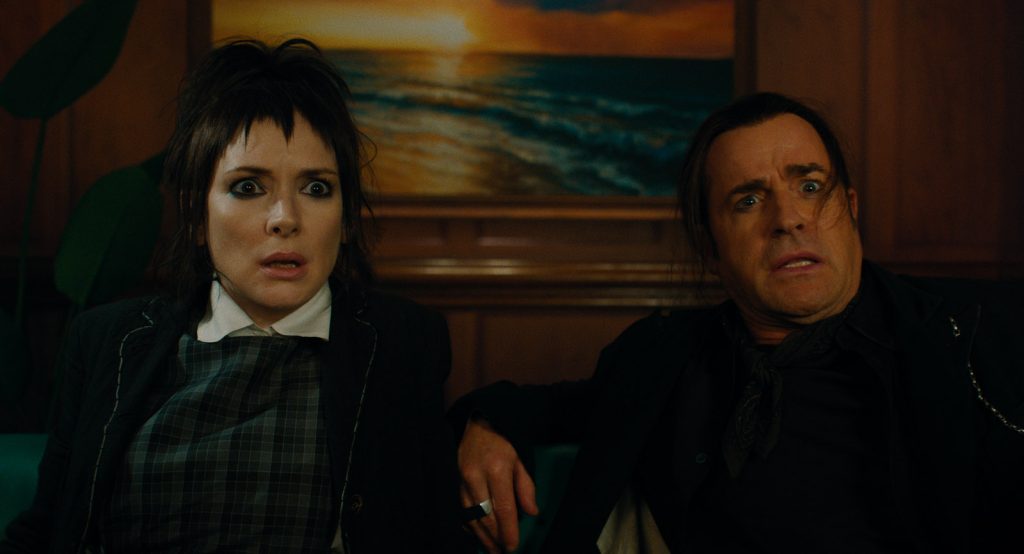
Entering the afterlife
Beetlejuice is renowned for its bold concept, performances, and colour, in part a result of Burton’s appreciation of the intense colour in Italian filmmaker Mario Bava’s work. When discussing tone, Zambarloukos expressed his love for the green light in the Afterlife of the original. “I said we shouldn’t throw it away but suggested creating a world where it undulates and moves and everything is kinetic and flickering,” he says. “Tim liked that idea so I showed him examples, we programmed in lighting changes and used some firelight to mix it up.”
As well as more vibrant colour, the Afterlife adopted a more kinetic camera than the real world. “We also wanted to concentrate more on portraiture as we had such great performances from actors such as Michael Keaton who Burton described as a prize fighter,” he says.
“You put him in the ring, and he just goes, so you can’t miss it, because there are only so many takes you could do at that high octane performance level. You have to capture it while people are on remote controls controlling eyes and lips of the Shrinker characters and on top of that there are lighting cues, real smoke, all in camera.”
When capturing the zany and frightening, Zambarloukos found comedy sequences were best shot slightly wider as characters providing amusement were physical in their performance. “Tim doesn’t change lenses much, it’s all about distance,” he says. “So we stuck to the wider spectrum of our lenses and moved closer or further away.”
Burton holds in specific ideas about what he wants until rehearsal when he manipulates where the actors move. Zambarloukos embraced the process of “arriving with the script and watching it unfold”, including the element of playfulness even present in horror sequences.
Sketches created by Burton informed the creative approach. “It’s a kind of free for all. I had some ideas, I did some sketches, and then I threw it out to everybody – the art department, the makeup department, craft services – anybody. It’s pooling ideas together,” says Burton.
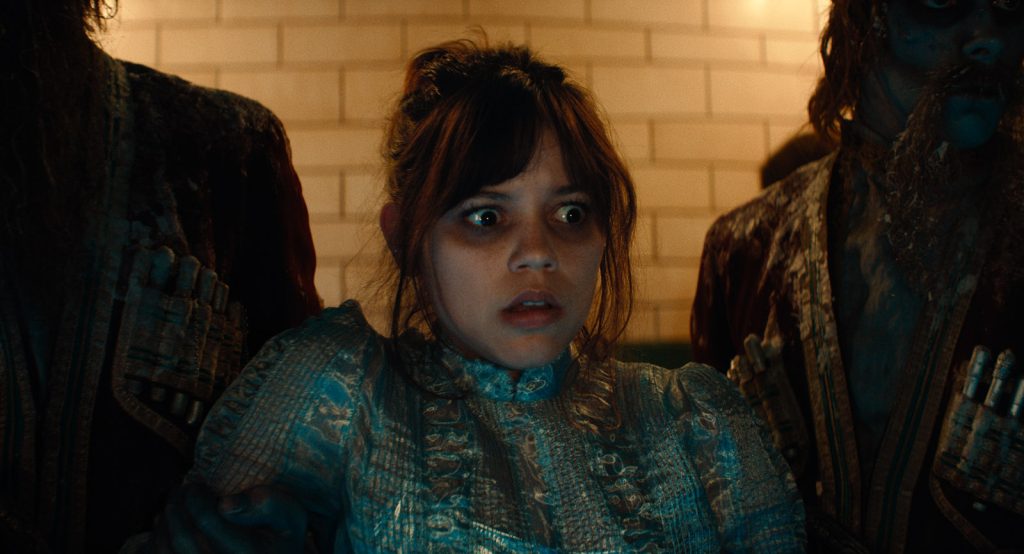
Zambarloukos took the director’s concept drawings as indications of shots. Sets were lit early so they could be walked through and lighting cues demoed during rehearsals while the cinematographer made notes to understand if his interpretation of what Burton likes was correct.
Due to the many lighting cues, camera moves were simplified. For example, when Dolores (Monica Belluchi) made her entrance she struggled to walk in her extravagant costume so Zambarloukos suggested putting her on a dolly so she floats. This pleased Burton who is enamoured by in camera slightly lo-fi solutions.
Camera movement and finding a solution that took care of coverage was essential to capture a pivotal dance sequence in a church. Zambarloukos is a fan of bodycam and frequently used it on A Haunting in Venice with key grip Malcolm Huse, who also worked on Beetlejuice Beetlejuice. They had put actors on the front of a slider and used it to rotate a camera around, but never put it on a dolly.
Along with camera operator Des Whelan and choreographer Corey Baker, the pair experimented, using stand ins for dancing Beetlejuice and Lydia on a dolly and pushing them as a camera span around them. “The camera could go up and down four times, and you could see all the other actors and never have to do coverage,” adds Zambarloukos. “When you attach cameras to actors and start moving, it has a dual function, so the shot becomes a close-up and a POV.”
Zambarloukos was thrilled to work with “master operator” Whelan whose crane work and operating wowed him as well as his 20-year collaboration with Burton. Having known Whelan for many years personally, Beetlejuice Beetlejuice provided an opportunity for Zambarloukos to work with him, finding the operator brought “a lot of confidence and skill, especially essential when choreographing many elements and only get one or two chances”.
The cinematographer also praises the Steadicam – which Burton has rarely used – achieved by Stamos Triantafyllos. He introduced using an AR camera rig for scenes such as Willem Dafoe’s character and his ghoul squad being chased in the cemetery. As it was not possible to fit a rotating rig into the small set for Astrid’s love interest Jeremy’s room – where the characters need to float – Triantafyllos suggested instead of moving the actors, moving his camera up on the AR rig to create the feeling they were floating.
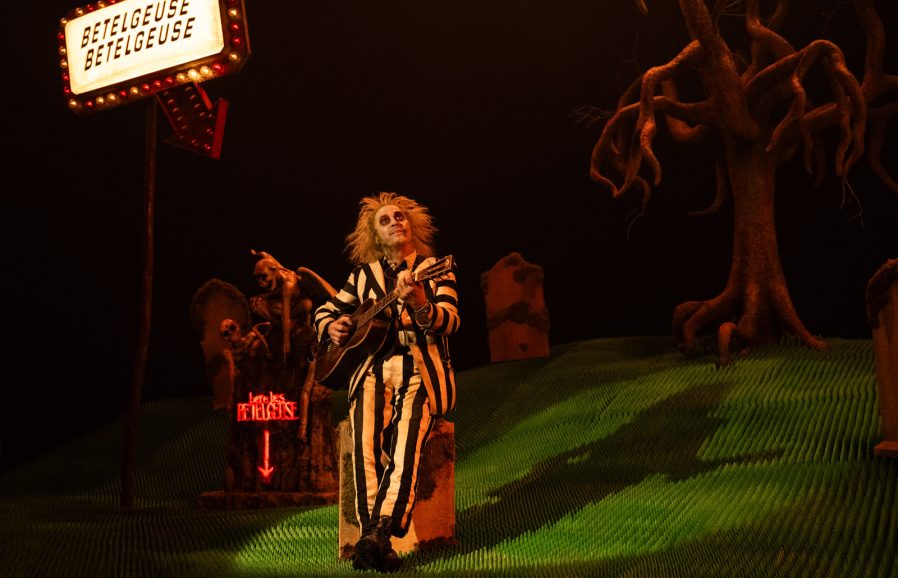
Using every pixel
Similarly to A Haunting in Venice, low light capacity was one reason the Sony Venice 2 was camera of choice for Zambarloukos: “And when I shoot daytime scenes at 3200 ASA, it has a particular texture in the gain that, to me, is similar to grain. There’s not much noise, but what noise there is I find visually pleasing.”
He finds the red curve in the warm tones well suited to shooting faces: “It seems made for the human face which is the most important aspect of filmmaking and photography. It’s also a decent size and then there’s the fidelity at 8.5K and Vista Vision size sensor.”
The combination of 1.85 aspect ratio – which Burton has always shot – the Venice 2’s sensor and the Panavision Ultra Panatar and Ultra Panatar II 1.3x anamorphic optics achieved the perfect visual blend. “The 1.3 anamorphic lenses become almost like a native 1.85. The methodology from now on with digital sensors is use every pixel so find a lens system and sensor that lets you achieve this when combined with your aspect ratio.”
Considering them “the crown jewels of Panavision”, Zambarloukos used some of the first sets of Auto Panatars and Ultra Panatars on A Haunting in Venice. “I don’t think there’s a better system and they’re very precious so by the time we were making Beetlejuice Beetlejuice Panavision had started making the first sets of Ultra and Auto Panatar II.”
Subtle Schneider Classic Soft filter then created a “slightly more glamourous” look for some characters to achieve the older film noir look Burton required. Zambarloukos also used a Sony FX 3, Leica Summilux-M lenses, and DJI Ronin 2 for select scenes such as a tracking shot of Astrid riding a bicycle downhill, which he wanted to be “intimate and fun” and capture the essence of what it is like to be a teenager on a bike ride.
“To do that, you have to free up the audience and actor to be playful,” he says. “The original discussions were about bringing U-Crane Arms and big equipment in but I wanted to use an electric bike and consumer camera. Key grip in the US, Frank Montecito, rode an electric bike and tracked Astrid on her bike, and there was also an FX 3 attached to Astrid’s bike.”
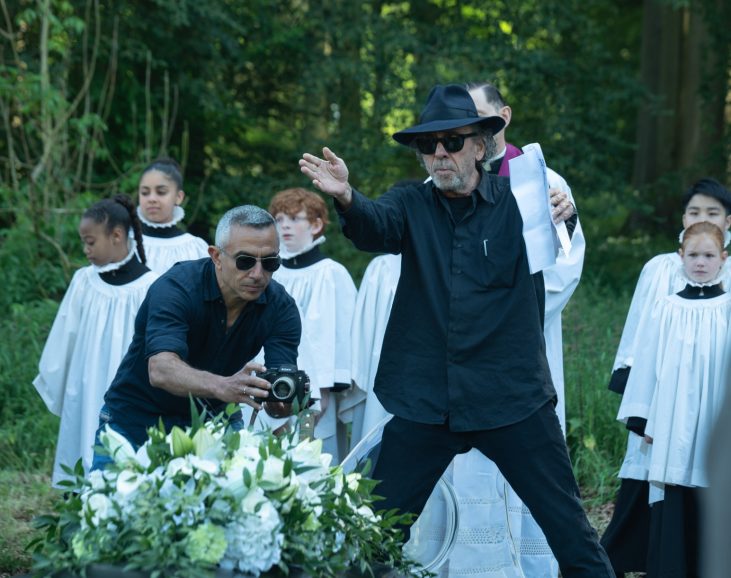
Going with the grain
Zambarloukos suggested using infrared to create the effect of dilated eyes for a sequence in which Lydia hosts a TV show and visits a haunted house. “The infrared filter on the Sony Venice 2 was removed and replaced after that scene. When you remove the infrared filter you could go anywhere with colour, but green seemed right as one of the phosphor sensitive infrared cameras from way back had a green tone.”
During testing he also decided daytime black-and-white infrared – which he had seen in films such as I Am Cuba (1964) – could be suitable for a flashback sequence explaining how Beetlejuice gets killed. 1st AC Dean Thompson played a crucial role during the process of infrared experimentation.
B Camera 1st AC Rana Darwish has been part of Zambarloukos’ team for a long time and also carried out some rigging on their latest project. “Whether it’s the Ronin or an underwater camera, Rana is great at finding the right way to achieve what we need,” says the DP.
While digital capture rather than shooting on film was deemed best, Zambarloukos embarked on an adventure of discovery to achieve the right look and feel for the creepy creation. Although he had never added artificial grain because he does not like the effect, he was curious about Live Grain and contacted technologist and director-cinematographer Suny Behar, the creator of Live Grain, to explain what he wanted to do with the black-and-white infrared sequence.
“Live Grain is a different analogue way of texture mapping where they develop and scan film stock – taking the real Kodak or AGFA charts – to figure out how much grain and movement is needed, depending on the colour and density,” he explains. “I asked Suny what his oldest stock was, and he told me he’d acquired the last two frozen cans of nitrate black-and-white from 1938 but was scared to develop them because you only get one chance.”
Instead of using halides, silver nitrate stock uses a combination of salt and crushed bones to make the nitrate. “It has a great texture and the nitrate is what holds the silver. So when working in black-and-white, once you’ve developed it you get rid of the halides, and are left with silver particles on acetate which is what you photograph.”
When Behar took the plunge and developed the film, Zambarloukos was so impressed by the results he used it for the whole production rather than just the black-and-white, adding the texture and luster of silver through the Live Grain application of a silver nitrate. He also suggested pushing the colours in the grade with Rob Pizzey, a colourist he admires and has worked with for 12 years.
“Tim was like, ‘Crank it up to 11, please.’ I also think he was taken by the 1938 silver nitrate being made out of bones and salt which added a Beetlejuice element to it!” adds the DP. “As Tim is particular about wanting some people a lot paler and others to look healthier having an extended grade was helpful to make refinements and allow him to be specific.”
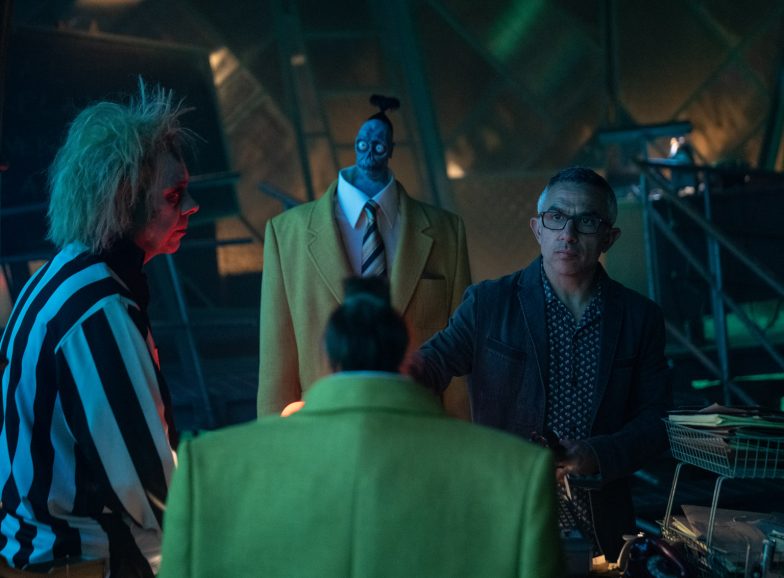
Creative choices
Animatronic and special makeup effects supervisor Neal Scanlan and hundreds of people working on creature effects created masterpieces. Designs evolved into physical models, often creating characters in a virtual environment before committing to making them.
Multiple departments and craftspeople created moulds, painted, and added hair. “We then engage with a group of performers who join us, rehearse and bring the character to life—either through physical rods, physical hand puppetry, by wearing the character, or maybe using things like animatronics, which is essentially radio-controlled robotic elements,” adds Scanlan.
Most of the shoot took place at Warner Bros. Studios Leavesden in the UK where sets like the church and house interior and environments from the Afterlife such as the waiting room and train platform were built. Hertfordshire, outside London, doubled for New York for scenes at a gallery and Astrid’s school while cemetery scenes were filmed in West Wickham.
Exterior scenes at Winter River were captured in East Corinth in Vermont, where the original Beetlejuice was also shot. The team rebuilt the house on the hill it was originally built and the red bridge was rebuilt which Astrid cycles across, but as she rides downhill they moved to Manchester-by-the-Sea in Boston. Her love interest Jeremy’s house and treehouse were also filmed in Boston, with the house interiors captured in the studio at Leavesden.
“Tim was very clear from the beginning – basically what was created in the original, but better,” says production designer, Mark Scruton. “We weren’t trying to reinvent the wheel in any way, shape, or form. We just had to expand on what had been laid down. And that was something that I took very close to my heart as well, because I’m a big fan of Bo Welch, who designed the original—and his work not just with Beetlejuice, but with all his films – and I didn’t want in any way to betray that legacy that he had laid down. And Tim didn’t either.”
The crew had different ideas about how to approach returning to Winter River. “But in the end, it always came back around to the fact that we had to go back to the real place and do it for real, because nothing else was really going to cut it,” says Scruton. “And nothing else really fitted with how Tim works anyway—everything needs to be real and complete, and doing digital extensions or any alternatives was never going to really work.”
One challenge was completing sets of varying scale and look in detail within the production schedule. “We had five soundstages at [Warner Bros. Studios] Leavesden. And I think, at last count, it was 68 sets that we had to constantly change and redress, move or have ready,” says Scruton. “It was a logistics effort as much as anything else to get everything in camera, because Tim is so specific about everything being complete environments, as opposed to relying on blue screen.”
Zambarloukos enjoyed the experience of working alongside Scruton who he considers a “collaborative and imaginative” designer. The cinematographer shared with him a desire to use the same technique to create the effect of sky or underwater he had deployed since Mama Mia – Rosco projection screens that are back lit instead of green or blue screen.
“On Death on the Nile we used 900 metres by 15 metres high of the screens outside the windows and dialed in the LED colour to create the kind of sky we needed. For the sandworm sequence of Beetlejuice Beetlejuice we used the same technique and the VFX took over and added structures and refined where the sky and sand meet,” he says. “It’s simpler and more affordable than other solutions, completely keyable, works well with VFX, and doubles up as a fantastic soft light source when not in shot.”
The visual effects team helping achieve a seamless result was headed up by VFX supervisor Angus Bickerton who worked with Burton on Dark Shadows. “Angus fully embraced this technique and comes from a motion control background which was helpful for the sandworm sequence which was old school puppeteering against our screens, seamless combined by Angus and his team,” says Zambarloukos.
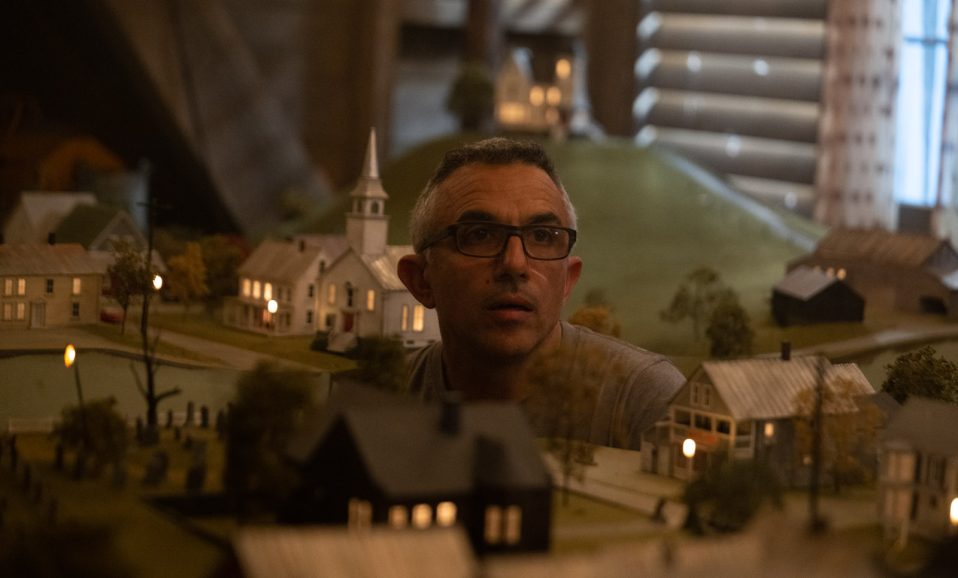
Magic in motion
Malcolm Hadley GBCT (Corpse Bride, Frankenweenie) was stop-motion cinematographer on three sequences, two involving the iconic sandworm and a flashback sequence where Delia Deetz recounts her husband’s death. Each sequence was filmed entirely using stop-motion animation, hand animated with fully armatured puppets and shot frame by frame. Burton wanted to return to techniques used in the original including stop-motion and worked with puppet specialists Mackinnon & Saunders with whom he has collaborated for over 30 years.
“Stop-motion has a unique texture and look that puts you into the world of the original movie. It’s no surprise stop-motion would make an appearance as Tim’s passion and fascination for it has been seen in many of his films, it’s where he came from in his early career in animation,” says Hadley.
The stop-motion universe is scaled down from the live action and puppets, sets and props made to a practical size for animators to work with. “Our shoot ran for several weeks with four animators working across five to six units. Although we were working to an animatic, our plane sequence was a standalone flashback, so we had more freedom to design shots and motion control camera moves which could be shared with Tim for feedback.”
For Hadley, stop-motion is a “perfect combination of an old technique supported by new technology in terms of capture, camera and lighting”. Alongside controlling the cameras, Dragonframe software also ran the motion control and DMX lighting, including an array of small LED strips and miniature practicals in plane which proved indispensable.
Hadley and his team began pre-lighting in August 2023 after Zambarloukos’ main unit photography at Leavesden had wrapped. He already broken down the approach and technical requirements with VFX supervisor Bickerton. “My initial prep was gathering information on how Haris shot the main unit shots the sandworm would need to occupy,” says Hadley, whose job was split in two – matching the sandworm’s cinematography to live action sequences through matching focal length, angle, scaled distance and height combined with matching lighting for texture, colour, and look.
He interpreted a large amount of camera data from Zambarloukos’ crew, providing technical information to help create line-ups. “We could do an onset mix and overlay to embed the sandworm in its desert environment, alongside test composites into the live action plates for checks before fully committing to beginning a stop-motion shot.”
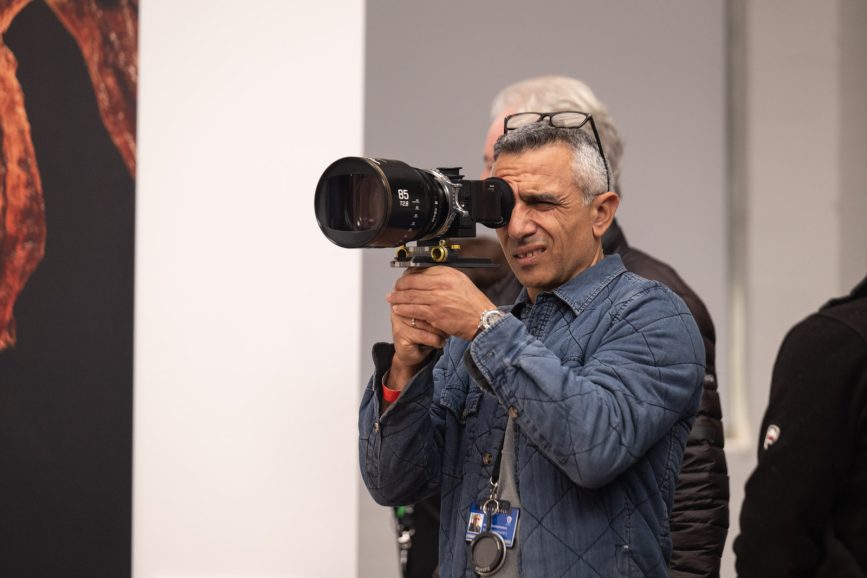
Choreographing colour
For a fast-paced, vibrant and precisely choreographed dance sequence taking place on a soul train and underground platform Zambarloukos worked with dimmer operator, Chris Craig, who he has teamed up with since Mamma Mia and gaffer, Dan Lowe, who he has collaborated with for 25 years, to explore how to approach creating the desired rainbow ‘70s effect.
“I wasn’t sure if a rainbow would work but suggested as we were using a lot of warm and cool colours they should programme in a pulse where lights in that blue, green world switch to a more amber, sodium world,” says Zambarloukos.
As with every project, Lowe and Zambarloukos began by sketching on paper before creating lighting plots in CAD lighting programme WYSIWYG which they also use as a dimmer control programme, numbering and channeling everything in prep.
Subtle lighting cues – from lightning flashes to changes of colour – were incorporated when needed, controlled by a five-way dimmer board. Some bespoke rigs were created with Lowe and practical electrician Joe McGee, including an LED version of a candle that could attach to a camera or be handheld, achieved working with clusters of LEDs at different temperatures programmed to flicker. As Zambarloukos likes eyelights reflected as a circle but “almost everything on the market is a rectangle or square” he asked Lowe and McGee to custom build bespoke dimmable circular LED lights that create a natural feeling when reflected in the iris.
Lowe suggested included the Luxor fixture his company Light Synthesis developed with Pro Light and which Zambarloukos found an invaluable “powerful LED and low-energy eco version of a Wendy light which can be broken down and used small”. They were used in custom made giant dimmable soft boxes, created by mounting fixtures together with tubing and truss and placing a screen in front.
Rarely lighting daytime outdoor scenes, the cinematographer used either ultra bounce or unbleached muslin. When lighting night scenes he worked with more smoke than he had experienced as “Tim likes to fog things up a lot”. The Luxors were useful for such situations and placed on cherry pickers to create a bluer moonlight combined with the Afterlife pulsing effect when needed.
Creamsource Vortexes, many ARRI SkyPanels, and some moving lights such as Ayrton Dominos completed the lighting line-up, with all fixtures supplied by Warner Bros Set Lighting. “As well as the few moving lights, we mainly put our flexi strip in fixtures and retrofitted practicals such as the soul train with RGBW LEDs, and programmed that in, so the set pulses and changes,” says Zambarloukos.
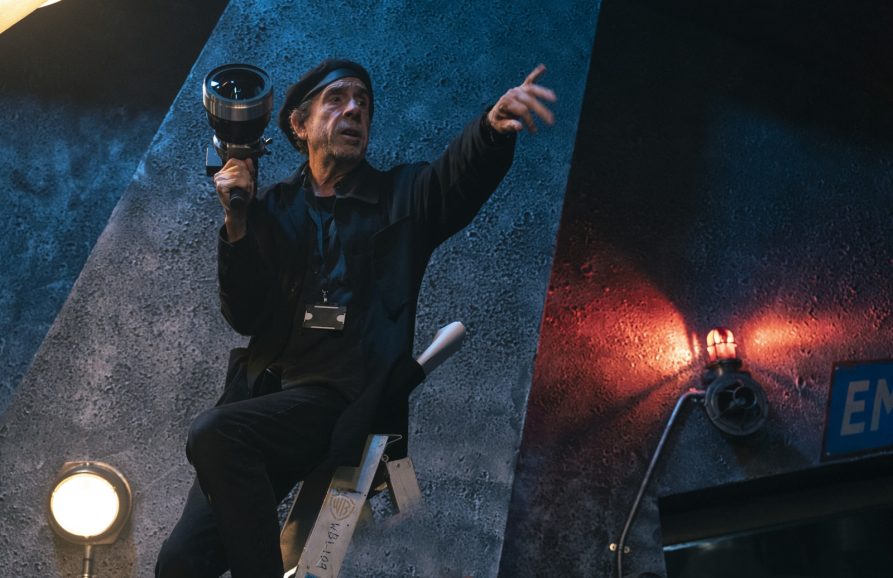
Capturing the creepiness
Beetlejuice Beetlejuice is the only film Zambarloukos has worked on with almost no deleted scenes, in part due to the nine-week schedule and complicated shoot. “You’d walk on set and there’s real special effects, lifts with skeletons going up and down and people walking around with javelins in their neck. I can’t describe it, I’ve never been on anything like that and I don’t think Tim has to that extent either since Beetlejuice,” he says. “That’s why nothing was wasted – it just takes so much care and attention to set it up.”
Visual interpretation was at the forefront of Burton’s process but, as Zambarloukos says, everything was also “completely personal” for the director. “There is nothing in the crazy world in any of his films that hasn’t come from his observation and contemplation of something. It’s remarkable.”
For example, when shooting Catherine O’Hara (who plays Delia Deetz), her eyes were often closed as she shakes her head. “But in one scene I said, ‘Tim, we can’t see her eyes. I think it’s just that she’s closing them too much.’ He replied, ‘Oh, I asked her to shut her eyes. Sometimes my mother would speak to me that way, and she’d have something important to say, but she’d shut her eyes and you couldn’t make contact.’ So it just goes to show that level of subtlety.”
The cinematographer believes that even in Burton’s most horrific films, there’s still a warm and engaging element. “He can marry the human condition, warmth, and visual virtuosity because everything comes from an internal part of him,” he adds. “So I never really went to another artist or film for references. I constantly looked inside of my own experience and observation to interpret things in a way I thought was suitable for what he wanted the film to be.”
